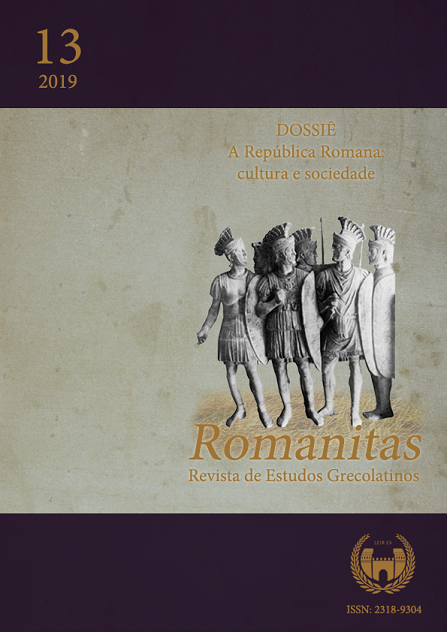Women in Martial’s eyes
DOI:
https://doi.org/10.17648/rom.v0i13.23056Keywords:
Epigram, Marcial, Female type, Latine literature, TranslationAbstract
In approximately 25% of his epigrams, of more than 1500, Martial presents the female gender as subject of the epigrammatic narrative, however, the poet varies the tone used in each narrated character. Now the poet points out an addiction, sometimes he throws mythological or historical themes, sometimes some consecrated person echoes, sometimes some woman who is part of the poet’s personal life is remembered by him, for example. Although they appear throughout Epigrammata, most of them are in books I, VIII, X, XII. Here, in this article, it was selected some types described by Martial, it is our aim to present the translation of these, in a panorama of how women were seen in First Century AD Rome.
Downloads
References
Documentação primária
CICERO. Epistolae ad familiares. Edited by D. R. Shackleton Bailey. Cambridge: Harvard University Press, 1977.
CICERO. Philippics. Translated by Gesine Manuwald. London: Walter de Gruyter, 2007.
QUINTILIAN. The instituto oratoria. Translated by H. E. Butler. Cambridge: Harvard University Press, 1969.
VALERIUS MAXIMUS. Memorable doing and sayings. Edition and translated by D. R. Shackleton Bailey. Cambridge: Harvard University Press, 2000.
OVID. Ars amatoria. Edited with introduction and commentary by Roy K. Gibson. Cambridge: Cambridge University Press, 2003.
MARTIAL. Epigrams; Spectacles: books 1-5. Edited and translated by D. R. Shackleton Bailey. Cambridge: Harvard University Press, 1993. v. I.
MARTIAL. Epigrams: books 6-10. Edited and translated by D. R. Shackleton Bailey. Cambridge: Harvard University Press, 1993.
MARTIAL. Epigrams: books 11-14. Edited and translated by D. R. Shackleton Bailey Cambridge: Harvard University Press, 1993.
Obras de apoio
AMARAL, F. V. Epigrama fúnebre e o contexto funerário. In: SARTORELLI, E. C; LIMA, R C; CESILA, R. T. (Org.). Vozes clássicas, ecos renascentistas: intertextualidade, epigrama, autores revisitados. São Paulo: Humanitas, 2017, p. 87‑107.
BOUISSER, G. Cicero and his friends: a study of Roman society in the time of Caesar. London: Ward, Lock & CO Ltda., 1898.
CESILA, R. T. Metapoesia nos epigramas de Marcial: tradução e análise. Dissertação (Mestrado em Linguística) - Programa de Pós-Graduação em Linguística da Universidade Estadual de Campinas, Campinas, 2004.
CLARK, G. Roman Women. Greece & Rome, v. 28, p. 193-212, 1981.
CLAASSEN, J.M. Tristia. In: KNOX, P. (Ed.). A Companion to Ovid. Oxford: Blackwell, 2009, p. 170‑183.
FEITOSA, L. C. Masculino e feminino na sociedade romana: os desafios de uma análise de gênero. In: CANDIDO, M. R. (Org.). Mulheres na Antiguidade: novas perspectivas e abordagens. Rio de Janeiro: DG, 2012, p. 203-218.
FEITOSA, L. C. Gênero e sexualidade no Mundo Romano: a Antiguidade em nossos dias. História: Questões & Debates, n. 48/49, p. 119-135, 2008.
FOXHALL, L. Studying gender in Classical Antiquity. Cambridge: Cambridge University Press, 2013.
GALDUF, A. La mujer en la Roma antigua: recuperando a la mujer romana. Arquehistoria, 8 mar. 2016. Disponível em: <http://arquehistoria.com/la-mujer-en-la-roma-antigua-5522>. Acesso em: 13 dez. 2018.
LIGHTMAN, M.; LIGHTMAN, B. A to Z of Ancient Greek and Roman women. New York: Facts on File, 2008.
PERROT, M. Práticas da memória feminina. Revista Brasileira de História, v. 9, n. 18, p. 09-18, 1989.
SANTIAGO, M.; FEITOSA, L. C. Família e gênero: um estudo antropológico. Mimesis, v. 32, n. 1, p. 29-41, 2011.
SHELTON, J. A. As the Romans did. New York: Oxford University Press, 1988.
Additional Files
Published
How to Cite
Issue
Section
License
Copyright (c) 2019 Romanitas - Revista de Estudos Grecolatinos

This work is licensed under a Creative Commons Attribution-NonCommercial-NoDerivatives 4.0 International License.
a. The authors retain copyright and grant the journal the right to first publication.
b. The authors are authorized to assume additional contracts separately, for non-exclusive distribution of the version of the work published in this journal (e.g., publishing in institutional repository or as a book chapter), with acknowledgment of authorship and initial publication in this journal.
c. Authors are allowed and encouraged to publish and distribute their work online (e.g. in institutional repositories or on their personal page) after the first publication by the journal, with due credit.
d. The journal's texts are licensed under a CC BY 4.0 Deed Attribution 4.0 International Licence (CC BY).




























